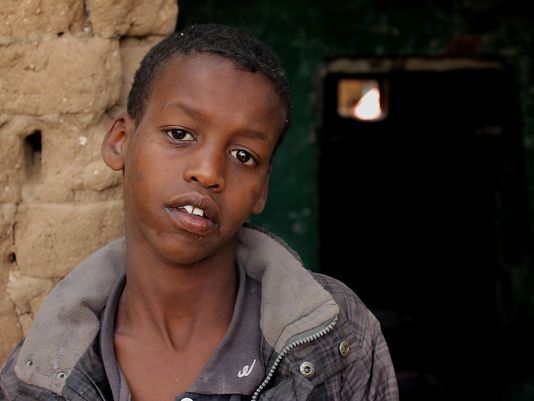Plastic bottles litter the ground as children emerge from an abandoned mud-brick building in this hot, dusty East African city.
The dirty bottles used for sniffing glue are a visible clue of what life is like for these homeless kids. “It takes away the pain I have,” Mohammed, 13, said, looking down at his sand-covered feet as other children take a hit of glue nearby. “The glue helps me go to sleep.”
Hargeisa is home to hundreds of street kids like Mohammed, who are victims of one of the worst droughts in the region over the past year. These sad-eyed children have nowhere else to go and often suffer from illnesses such as tuberculosis.
Poverty-stricken children surviving on the streets of Somali cities is not new but the sheer number is. The government estimates one-fifth of the kids on the streets of Somalia’s second-largest city are there because of the devastating drought.
Teenagers and young homeless adults fiercely guard the dilapidated building where Mohammed sleeps. A putrid stench radiates from the murky hole in the building’s wall that the youngsters enter and exit through.
Several of the children interviewed coughed as they lamented that they were getting sicker and their clothes were becoming tattered rags.
“But these rural children have no skills to help them find work in the cities, so they end up living on the street and getting addicted to drugs,” he said.
USA TODAY is withholding the full names of the children interviewed because they are minors.
The glue-addicted children beg in the streets and frequently end up fighting each other. Some of the battles turn fatal. The same week USA TODAY visited Mohammed, one of his friends was beaten to death.
“We have a lot of problems from the fights. My ribs hurt because of the fighting,” Mohammed said. “When I’m using glue, someone will try and grab me and take the glue from me to have for their own, and then the fights start.”
Deaths caused by malnutrition and diarrhea are not uncommon in the worst hit parts of the country. At least 50 people died from diarrhea in recent weeks, according to Adis Salah, the mayor of the nearby Baladiye District.
Some poverty-stricken parents have sent their children to urban centers in hopes of giving them a better life.
Sakkari, 14, ended up polishing shoes after being sent to Hargeisa by his parents to escape the drought.
“When the drought began, I was sent to Hargeisa to live with an aunt,” Sakkari said. “But my aunt had many children in Hargeisa and we didn’t get on. We had a fight one day and I ran away.”
“I’ve not heard from my family for months. I think their situation must be bad,” Sakkari added.
Other children have become homeless after being separated from their family as thousands of Somalis became displaced in the desperate search for water, food and grazing land for animals.
Abdelqader is one of the homeless children. “I lost them,” the 12-year-old boy said, looking down. “That’s how I ended up on the streets.”
His family was forced to leave their village when water ran out, and Abdelqader got lost in an unfamiliar place when he collected water to bring back to his family. Carrying a full jerrycan but with no idea where to go, the boy walked for three days in desert-like terrain hungry and exhausted before he found a main road.
Flagging down a truck, Abdelqader asked to be taken to the nearest city. Hours later he found himself in Hargeisa facing a night in the biggest and scariest place he’d ever been.
“I didn’t know how to survive in the town on my own. I spent days and nights without food. Some people saw me struggling and gave me some food and water,” Abdelqader said.
After some weeks surviving on the streets in one of the world’s poorest nations, Abdelqader was picked up by the government and taken to a center for street children on the outskirts of Hargeisa.
That center is prison-like in it’s appearance but provides a bed, food and schooling. It takes care of around 100 destitute children. However, the center is already running at full capacity, and 3,000 more street children remain in Hargeisa alone.
In Somalia’s capital of Mogadishu, one of the world’s most dangerous cities, another 5,000 children are believed to be homeless.
As the drought continues with no end in sight, even more children may soon be on the streets.
“Sleeping on the streets was the worst experience of my life. The other children beat me,” Abdelqader said. “I feel lucky that I’m not there anymore. I hope to find my family again.”
By Matthew Vickery, Special for USA TODAY
Cover Photo: 13-year-old Mohammed who lives on the streets of Hargeisa, stands outside the abandoned building where he sleeps with other homeless children and adults.(Photo: Matthew Vickery, Special for USA TODAY)
![]()






























